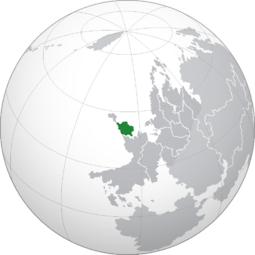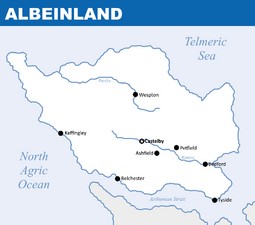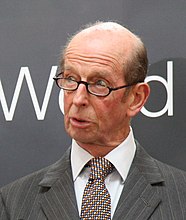Albeinland
This article is incomplete because it is pending further input from participants, or it is a work-in-progress by one author. Please comment on this article's talk page to share your input, comments and questions. Note: To contribute to this article, you may need to seek help from the author(s) of this page. |
Commonwealth of Albeinland | |
|---|---|
| Motto: Domine, dirige nos (Cambran) "O Lord, direct us" | |
| Anthem: Battle Hymn of the Republic
| |
 Albeinland (green) in Berea (grey) | |
 Political map of Albeinland | |
| Capital and largest city | |
| Ethnic groups (2020) | 87.9% White 7.2% Black 3.3% Pamiran 2.2% Mixed 0.1% Other |
| Religion (2020) | 88.2% Semitarism -74.9% Cambran sect -12.5% Nordic sect -0.8% Erytheian sect 7.3% Irreligious 4.1% Iqlad 0.4% Other |
| Demonym(s) | Albish |
| Government | Federal parliamentary republic |
| George Owen | |
| Vincent Lloyd | |
| Legislature | General Assembly |
| State Council | |
| House of Commons | |
| Establishment | |
| 10 May 1583 | |
| 13 November 1786 | |
• BDTA | 17 June 1944 |
| Area | |
• Total | 182,054 km2 (70,291 sq mi) |
• Water (%) | 0.6 |
| Population | |
• 2020 census | 6,472,318 |
• Density | 35.5/km2 (91.9/sq mi) |
| GDP (nominal) | 2020 estimate |
• Total | |
• Per capita | |
| Gini (2020) | low |
| HDI (2020) | very high |
| Currency | Sterling (ALB, £) |
| Time zone | UTC+1 (Albish Central Time) |
| Calling code | +16 |
| Internet TLD | .ab |
Albeinland, officially the Commonwealth of Albeinland, is an insular country located on the continent of Beria, sharing a maritime boundary with Sileria to the west and having a coastline on the Arthurean Strait to the south, the Telmeric Sea to the north and the North Agric Ocean to the west. With 6,472,318 inhabitants and 182,054 km² (70,291 sq mi), Albeinland is one of the smallest countries of the world.
The current Albish territory is populated since the Paleolithic era, with the first Foranic peoples migrating to the region in the 5th century BCE. The island would be annexed by the Cambran Empire years later in 85 CE, with the region becoming an important trade hub due to its strategic location in northwestern Beria. After the fall of the Cambran Empire, Albeinland would fracture itself into various petty kingdoms and tribes, leaving the area open for a series of intensive Cuthish immigrations during the 3rd and 4th centuries. The new Cuthish population consolidated themselves as the new elite of the region, with a series of merchant republics, market guilds and college towns being established. The fragility of these states caused the creation of the Albish League at the end of the 9th century, a defensive and trade pact to ensure the independence of all member-states, leading to total Albish domination over commercial routes in the Telmeric Sea and Agric Ocean, with the Loubergian nobility setting the foundation for the creation of current Albish language.
After the Albish defeat at the First Cutho-Albish War in 1582, a series of nationalist movements overthrew the previous maritime republics and unified them into the Commonwealth of Albeinland, the first republic of its kind. The Commonwealth saw the expansion of Albish trade activities outside Beria with the creation of trade outposts in Pamira and Capthora, and established one of the first colonial empires of Aurorum. Internal disputes led to the end of the republic and the establishment of an enlightened monarchy in 1732, with the 18th century being known as a golden era as the country stayed in a good economic and foreign situation whilst being at the centre of most philosophic and scientific discussions of the era. However, further political instability led to the Albish Spring in 1786, with a new democratic republic taking place.
The 1800s were marked by extensive industrialization, urbanization and expansion of colonial holdings, followed by the expansion of suffrage to the population. Albeinland was one of the major combatants of the Great War, with its navy seeing action in every corner of the world. The end of the war led to various independence movements in its domains, especially Sileria, throughout the world, with the decolonization process happening gradually over the century. After the end of the Melasian Crisis, Albeinland was one of the founder-states, alongside Mascylla, of the Berean Defence Treaty Association, acting as the "bastion of the free world" against the Mageiros League and the Perekovka Program. The country was severely hit in the general crisis of 1986, having been recovered since then.
Today, Albeinland is a developed country with a high-income economy, being regarded as one of the main colonial empires in history, and still is capable of heavily shaping the modern geopolitical scenario, having the Albish language and culture present on every corner of the world. Its capital and primate city is Castelby. The political framework is operated under a federal parliamentary republic with the Lord-Protector being the chief of state while the Prime Minister is the chief of government, and has as its national legislature the bicameral General Assembly, which has as its lower house the House of Commons and upper house the State Council. Given the nature of its political system, many specialists consider Albeinland to be a crowned republic. Currently, Albeinland is a member of the Assembly of Nations and the Berean Defence Treaty Association, among other international organizations.





